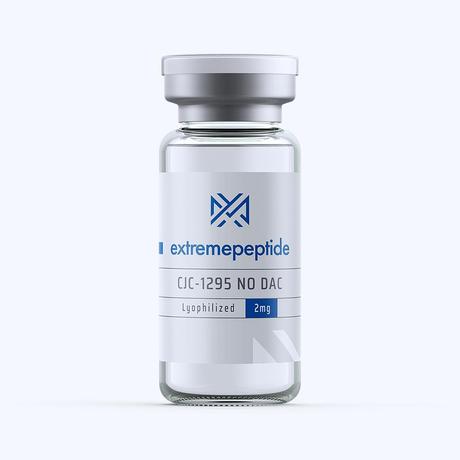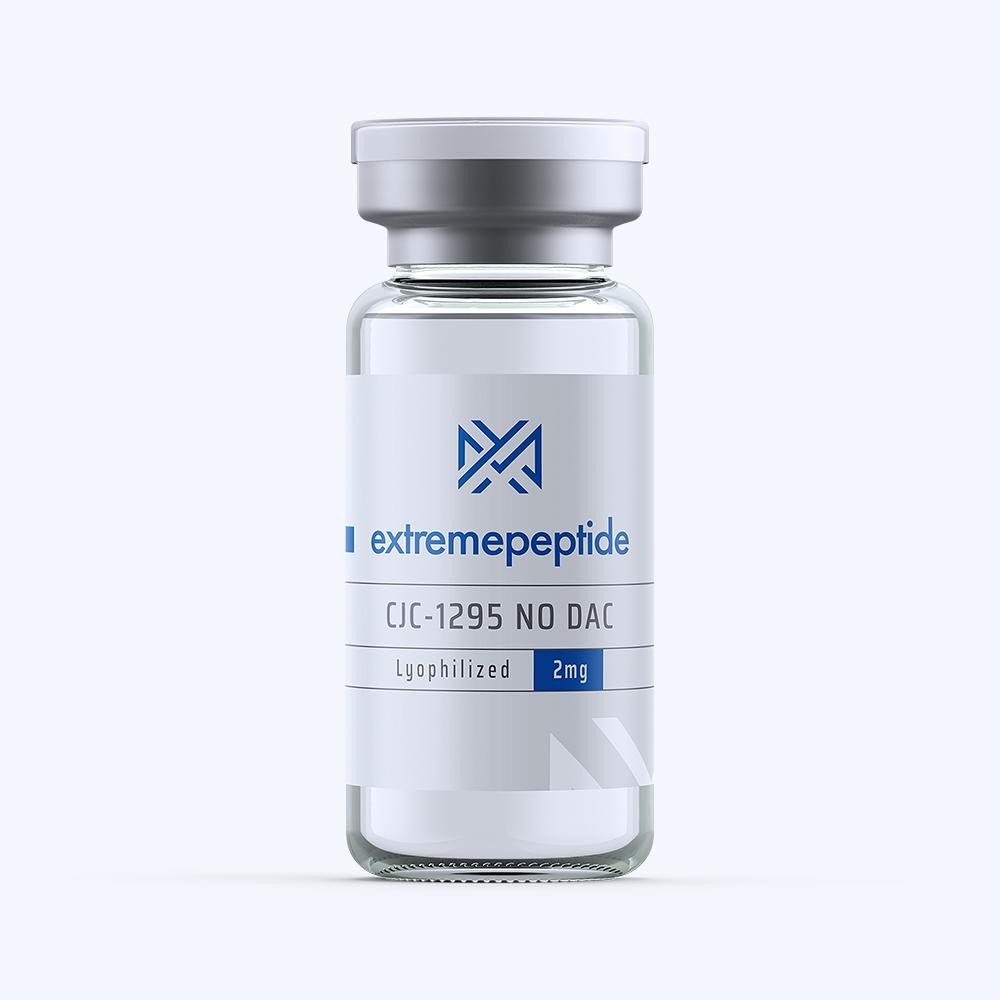Sale!


CJC-1295 NO-DAC (MOD GRF 1-29)
In stock
$25.99$39.99
- Concentration
- 2 mg per vial
Free & Fast
Shipping
Earn
Rewards
Excellent
Service

$25.99$39.99
Free & Fast
Shipping
Earn
Rewards
Excellent
Service
| Molecular Formula | C152H252N44O42 |
| Molecular Weight | 3367.9 |
| Monoisotopic Mass | 3365.8935782 |
| Polar Area | 1450 |
| Complexity | 7710 |
| XLogP | -10.7 |
| Heavy Atom Count | 238 |
| Hydrogen Bond Donor Count | 52 |
| Hydrogen Bond Acceptor Count | 48 |
| Rotatable Bond Count | 118 |
| Physical Appearance | Fine White Lyophilized Powder |
| Stability | Lyophilized protein is to be stored at -20°C. It is recommended to aliquot the reconstituted (dissolved) protein into several discrete vials in order to avoid repeated freezing and thawing. Reconstituted protein can be stored at 4°C |
| PubChem LCSS | CJC-1295 NO-DAC (MOD GRF 1-29) Laboratory Chemical Safety Summary |
| Property | Property Value |
|---|---|
| CID | 56841945 |
| InChI | InChI=1S/C152H252N44O42/c1-22-79(15)118(194-125(214)84(20)171-135(224)107(68-115(206)207)181-124(213)81(17)169-126(215)91(155)65-87-41-45-89(201)46-42-87)147(236)189-106(66-86-34-25-24-26-35-86)141(230)196-120(85(21)200)149(238)180-99(51-54-114(158)205)132(221)190-111(72-199)145(234)185-105(67-88-43-47-90(202)48-44-88)140(229)178-96(40-33-59-168-152(164)165)128(217)177-94(37-28-30-56-154)133(222)193-117(78(13)14)146(235)187-100(60-73(3)4)134(223)170-82(18)123(212)175-97(49-52-112(156)203)130(219)183-103(63-76(9)10)138(227)191-109(70-197)143(232)172-83(19)122(211)174-95(39-32-58-167-151(162)163)127(216)176-93(36-27-29-55-153)129(218)182-102(62-75(7)8)137(226)184-101(61-74(5)6)136(225)179-98(50-53-113(157)204)131(220)186-108(69-116(208)209)142(231)195-119(80(16)23-2)148(237)188-104(64-77(11)12)139(228)192-110(71-198)144(233)173-92(121(159)210)38-31-57-166-150(160)161/h24-26, 34-35, 41-48, 73-85, 91-111, 117-120, 197-202H, 22-23, 27-33, 36-40, 49-72, 153-155H2, 1-21H3, (H2, 156, 203)(H2, 157, 204)(H2, 158, 205)(H2, 159, 210)(H, 169, 215)(H, 170, 223)(H, 171, 224)(H, 172, 232)(H, 173, 233)(H, 174, 211)(H, 175, 212)(H, 176, 216)(H, 177, 217)(H, 178, 229)(H, 179, 225)(H, 180, 238)(H, 181, 213)(H, 182, 218)(H, 183, 219)(H, 184, 226)(H, 185, 234)(H, 186, 220)(H, 187, 235)(H, 188, 237)(H, 189, 236)(H, 190, 221)(H, 191, 227)(H, 192, 228)(H, 193, 222)(H, 194, 214)(H, 195, 231)(H, 196, 230)(H, 206, 207)(H, 208, 209)(H4, 160, 161, 166)(H4, 162, 163, 167)(H4, 164, 165, 168)/t79-, 80-, 81+, 82-, 83-, 84-, 85+, 91-, 92-, 93-, 94-, 95-, 96-, 97-, 98-, 99-, 100-, 101-, 102-, 103-, 104-, 105-, 106-, 107-, 108-, 109-, 110-, 111-, 117-, 118-, 119-, 120-/m0/s1 |
| InChIKey | XOZMWINMZMMOBR-HRDSVTNWSA-N |
| Isomeric SMILES | CC[C@H](C)[C@@H](C(=O)N[C@@H](CC1=CC=CC=C1)C(=O)N[C@@H]([C@@H](C)O)C(=O)N[C@@H](CCC(=O)N)C(=O)N[C@@H](CO)C(=O)N[C@@H](CC2=CC=C(C=C2)O)C(=O)N[C@@H](CCCNC(=N)N)C(=O)N[C@@H](CCCCN)C(=O)N[C@@H](C(C)C)C(=O)N[C@@H](CC(C)C)C(=O)N[C@@H](C)C(=O)N[C@@H](CCC(=O)N)C(=O)N[C@@H](CC(C)C)C(=O)N[C@@H](CO)C(=O)N[C@@H](C)C(=O)N[C@@H](CCCNC(=N)N)C(=O)N[C@@H](CCCCN)C(=O)N[C@@H](CC(C)C)C(=O)N[C@@H](CC(C)C)C(=O)N[C@@H](CCC(=O)N)C(=O)N[C@@H](CC(=O)O)C(=O)N[C@@H]([C@@H](C)CC)C(=O)N[C@@H](CC(C)C)C(=O)N[C@@H](CO)C(=O)N[C@@H](CCCNC(=N)N)C(=O)N)NC(=O)[C@H](C)NC(=O)[C@H](CC(=O)O)NC(=O)[C@@H](C)NC(=O)[C@H](CC3=CC=C(C=C3)O)N |
| Canonical SMILES | CCC(C)C(C(=O)NC(CC1=CC=CC=C1)C(=O)NC(C(C)O)C(=O)NC(CCC(=O)N)C(=O)NC(CO)C(=O)NC(CC2=CC=C(C=C2)O)C(=O)NC(CCCNC(=N)N)C(=O)NC(CCCCN)C(=O)NC(C(C)C)C(=O)NC(CC(C)C)C(=O)NC(C)C(=O)NC(CCC(=O)N)C(=O)NC(CC(C)C)C(=O)NC(CO)C(=O)NC(C)C(=O)NC(CCCNC(=N)N)C(=O)NC(CCCCN)C(=O)NC(CC(C)C)C(=O)NC(CC(C)C)C(=O)NC(CCC(=O)N)C(=O)NC(CC(=O)O)C(=O)NC(C(C)CC)C(=O)NC(CC(C)C)C(=O)NC(CO)C(=O)NC(CCCNC(=N)N)C(=O)N)NC(=O)C(C)NC(=O)C(CC(=O)O)NC(=O)C(C)NC(=O)C(CC3=CC=C(C=C3)O)N |
| IUPAC Name | (3S)-4-[[(2S)-1-[[(2S, 3S)-1-[[(2S)-1-[[(2S, 3R)-1-[[(2S)-5-amino-1-[[(2S)-1-[[(2S)-1-[[(2S)-1-[[(2S)-6-amino-1-[[(2S)-1-[[(2S)-1-[[(2S)-1-[[(2S)-5-amino-1-[[(2S)-1-[[(2S)-1-[[(2S)-1-[[(2S)-1-[[(2S)-6-amino-1-[[(2S)-1-[[(2S)-1-[[(2S)-5-amino-1-[[(2S)-1-[[(2S, 3S)-1-[[(2S)-1-[[(2S)-1-[[(2S)-1-amino-5-carbamimidamido-1-oxopentan-2-yl]amino]-3-hydroxy-1-oxopropan-2-yl]amino]-4-methyl-1-oxopentan-2-yl]amino]-3-methyl-1-oxopentan-2-yl]amino]-3-carboxy-1-oxopropan-2-yl]amino]-1, 5-dioxopentan-2-yl]amino]-4-methyl-1-oxopentan-2-yl]amino]-4-methyl-1-oxopentan-2-yl]amino]-1-oxohexan-2-yl]amino]-5-carbamimidamido-1-oxopentan-2-yl]amino]-1-oxopropan-2-yl]amino]-3-hydroxy-1-oxopropan-2-yl]amino]-4-methyl-1-oxopentan-2-yl]amino]-1, 5-dioxopentan-2-yl]amino]-1-oxopropan-2-yl]amino]-4-methyl-1-oxopentan-2-yl]amino]-3-methyl-1-oxobutan-2-yl]amino]-1-oxohexan-2-yl]amino]-5-carbamimidamido-1-oxopentan-2-yl]amino]-3-(4-hydroxyphenyl)-1-oxopropan-2-yl]amino]-3-hydroxy-1-oxopropan-2-yl]amino]-1, 5-dioxopentan-2-yl]amino]-3-hydroxy-1-oxobutan-2-yl]amino]-1-oxo-3-phenylpropan-2-yl]amino]-3-methyl-1-oxopentan-2-yl]amino]-1-oxopropan-2-yl]amino]-3-[[(2R)-2-[[(2S)-2-amino-3-(4-hydroxyphenyl)propanoyl]amino]propanoyl]amino]-4-oxobutanoic acid |
| CAS | 446262-90-4 |
Generated by Extreme Peptide with Open Babel, version 2.3.1, http://openbabel.org (accessed May 20, 2024)
Accurate research is our priority.
Get 25% off your first order and all the latest information on events, sales, & offers.
We care about keeping your data private. Read our Privacy Policy.

